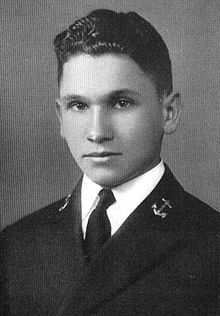Joseph Weber (physicist)
Joseph Weber (born May 17, 1919 in Paterson , New Jersey , † September 30, 2000 in Pittsburgh , Pennsylvania ) was an American physicist , known as a pioneer of gravitational wave experiments and one of the pioneers of the laser .
origin
Weber's parents were actually called Gerber (and Joseph Weber originally Jonas), but immigrated to the USA with a false visa in the name of Weber . His father was from Lithuania , his mother from Latvia .
life and work
Weber studied at the US Naval Academy in Annapolis. After participating in World War II , in which Weber served in the Navy, he taught and researched at the University of Maryland at College Park . In 1948 he became a professor of electrical engineering there, but at the same time began to study physics at the Catholic University of America, where he received his doctorate in 1951 ( The microwave inversion spectrum of ammonia ). In 1961 he became a professor of physics at the University of Maryland. In 1989 he retired.
Weber made important contributions in the field of laser technology ; he recognized the maser principle before Gordon , Zeiger and Charles Townes and presented it in 1952 and 1953. However, he only discussed the maser principle as an amplifier and did not try to build a maser. In addition, his suggestion of how to achieve population inversion was impractical. In recognition of this achievement, he became a Fellow of the IRE (Institute of Radio Engineers) in 1958 and received the Washington Academy of Science award in 1958. In 1955 he is at the Institute for Advanced Study and deals with general relativity, about which he also heard from John Archibald Wheeler in Leiden in 1956 , where there were discussions about gravitational waves with Charles Misner and Wheeler . Then in the 1960s he developed the first detectors for gravitational waves.
Weber was convinced that he had detected gravitational waves with his detectors , which consisted of large aluminum metal cylinders with glued-on piezo elements and which he built from 1960. In the 1960s he caused a sensation with it. In 1969 he reported the detection of a gravitational wave from a coincidence measurement of detectors in Maryland and in the Argonne National Laboratory (1000 km apart). However, since his results could not be reproduced by other researchers, his experimental results are controversial. Richard Garwin in particular heavily criticized Weber's experiments in the 1970s. Weber continued his experiments (for example, he thought he had found coincidences of gravitational wave measurements with the neutrino measurements from the supernova 1987A and in the 1990s with gamma-ray flashes ), but the impression that his colleagues had consolidated that Weber's method did not produce any significant results were achievable.
However, Weber deserves the credit for making research on gravitational waves popular.
He was married to the astronomer Virginia Trimble in 1973 in second marriage . From his first marriage to Anita Straus (she died in 1971) he had four sons.
In 1972 he received the Boris Pregel Award and in 1970 the Sigma Xi Award and the Babson Award from the Gravity Research Foundation. In 1959 he received the first prize from the Gravity Research Foundation. He was a Guggenheim Fellow from 1955 to 1956 and 1962 to 1963, a Fellow of the American Physical Society in 1960 and a Fulbright Fellow in 1963. In 1988 he was inducted into the Maryland Engineering Hall of Fame.
Virginia Trimble donated the American Astronomical Society's first Joseph Weber Award in 2002 for advances in astronomical instrument making.
Fonts
- General Relativity and Gravitational Waves. In: Interscience , 1961.
- Detection and Generation of Gravitational Waves. In: Physical Review , Vol. 117, 1960, p. 306.
Web links
- Summary of his life and work by Peter Aufmuth, presentation slides (PDF file; 1.33 MB)
Remarks
- ↑ As a lieutenant on the aircraft carrier USS Lexington , with which he left Pearl Harbor two days before the attack by the Japanese and whose sinking he survived in 1942, he was then the commander of a destroyer escort for Atlantic convoys for anti-submarine defense. He also took part in the Allied invasion of Sicily in 1943.
- ↑ After he last worked as an electronics expert in the Navy, specifically for electronic countermeasures for radar. Most recently he was corvette captain.
- ↑ Amplification of microwave radiation by substances not in thermal equilibrium , Transactions IRE, Vol. 3, 1953, p. 1.
- ↑ Presented in 1952 at the Electronic Tube Research Conference in Ottawa. Bertolotti History of the Laser , Institute of Physics 2005, Chapter 10
- ↑ He proposed a method similar to Edward Mills Purcell's experiment to generate negative temperatures, which also initiated Townes' ideas about the burl. Bertolotti, loc. Cit.
- ↑ as well as 1962/63 and 1969/70
- ^ Wheeler, Weber Reality of Cylindrical Gravitational Waves of Einstein and Rosen , Rev.Mod.Phys., Vol. 29, 1957, p. 509, Chapel Hill Conference
- ^ Weber Evidence for discovery of gravitational radiation , Phys. Rev. Letters, Vol. 22, 1969, p.1320, Gravitational Radiation Experiments , Phys. Rev. Letters, Vol. 24, 1970, p. 276. He had already reported on coincidences at smaller distances.
- ↑ For example in the 1970s Anthony Tyson from Bell Laboratories , Heinz Billing with Peter Kafka (Munich), Richard Garwin at IBM
- ^ Debate in Physics Today 1974, 1975
| personal data | |
|---|---|
| SURNAME | Weber, Joseph |
| BRIEF DESCRIPTION | American physicist |
| DATE OF BIRTH | May 17, 1919 |
| PLACE OF BIRTH | Paterson , New Jersey |
| DATE OF DEATH | September 30, 2000 |
| Place of death | Pittsburgh , Pennsylvania |
